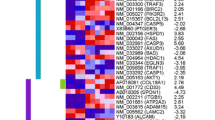Abstract
The aim of the study is to the determine the profiles of cell cycle genes and a new candidate oncogene of URG4/URGCP which play role in leukemia, establishing the association between the early prognosis of cancer and the quantitation of genetic changes, and bringing a molecular approach to definite diagnosis. In this study, 36 newly diagnosed patients’ with ALL-AML in the range of 0–18 years and six control group patients’ bone marrow samples were included. Total RNA was isolated from samples and then complementary DNA synthesis was performed. The obtained cDNAs have been installed 96 well plates after prepared appropriate mixtures and assessed with LightCycler® 480 Real-Time PCR quantitatively. CHEK1, URG4/URGCP, CCNG1, CCNC, CDC16, KRAS, CDKN2D genes in the T-ALL group; CCND2, ATM, CDK8, CHEK1, TP53, CHEK2, CCNG2, CDK4, CDKN2A, E2F4, CCNC, KRAS genes in the precursor B-ALL group and CCND2, CDK6 genes in the AML group have shown significant increase in mRNA expression level. In the featured role of acute leukemia the regulating signaling pathways of leukemogenesis partially defined, although identification of new genetic markers in acute leukemia subgroups, will allow the development of early diagnostic and new treatment protocols.
Similar content being viewed by others

References
Biondi A, Cimino G, Pieters R, Pui CH (2000) Biological and therapeutic aspects of infant leukemia. Blood 96:24–33
Mullighan CG, Goorha S, Radtke I et al (2007) Genome-wide analysis of genetic alterations in acute lymphoblastic leukaemia. Nature 446:758–764
Sherr CJ (1996) Cancer cell cycles. Science 274:1672
Clarke MF, Dick JE, Dirks PB et al (2006) Cancer stem cells–perspectives on current status and future directions: AACR Workshop on cancer stem cells. Cancer Res 66:9339–9344
Benekli M, Baer MR, Baumann H et al (2003) Signal transducer and activator of transcription proteins in leukemias. Blood 101:2940–2954
Gesbert F, Griffin JD et al (2000) Bcr/Abl activates transcription of the Bcl-X gene through STAT5. Blood 96:2269–2276
Satiroglu-Tufan NL, Dodurga Y, Gok D, Cetinkaya A, Feitelson MA (2010) RNA interference-mediated URG4 gene silencing diminishes cyclin D1 mRNA expression in HepG2 cells. Genet Mol Res 9(3):1557–1567
Tufan NL, Lian Z, Liu J et al (2002) Hepatitis Bx antigen stimulates expression of a novel cellular gene, URG4, that promotes hepatocellular growth and survival. Neoplasia 4(4):355–368
Song J, Xie H, Lian Z et al (2006) Enhanced cell survival of gastric cancer cells by a novel gene URG4. Neoplasia 8(12):995–1002
Huang J, Zhu B, Lu L et al (2009) The expression of novel gene URG4 in osteosarcoma: correlation with patients prognosis. Pathology 41(2):149–154
Dodurga Y, Avcı CB, Susluer SY, Satıroğlu Tufan NL, Gündüz C (2012) The expression of URGCP gene in prostate cancer cell lines: correlation with rapamycin. Mol Biol Rep. doi:10.1007/s11033-012-1891-6
Shiloh Y, Kastan MB et al (2001) ATM: genome stability, neuronal development, and cancer cross paths. Adv Cancer Res 83:209–254
Lavin MF, Birrell G, Chen P et al (2005) ATM signaling and genomic stability in response to DNA damage. Mutat Res 569(1–2):123–132
Takagaki K, Katsuma S, Kaminishi Y et al (2005) Role of Chk1 and Chk2 in Ara-C-ınduced differentiation of human leukemia K562 cells. Genes Cells 10:97–106
Halicka HD, Ozkaynak MF, Levendoglu-Tugal O et al (2009) DNA damage response as a biomarker in treatment of leukemias. Cell Cycle 8(11):1720–1724
Khanna KK, Keating KE, Kozlov S et al (1998) ATM associates with and phosphorylates p53: mapping the region of ınteraction. Nat Genet 20:398–400
Shafman T, Khanna KK, Kedar P et al (1997) Interaction between ATM protein and c-Abl in response to DNA damage. Nature 387:520–523
Soenen V, Lepelley P, Gyan E et al (2001) Prognostic significance of p16ınk4a ımmunocytochemistry in adult ALL with standard risk karyotype. Leukemia 15:1054–1059
Dalle JH, Fournier M, Nelken B et al (2000) p16INK4a ımmunocytochemical analysis is an ındependent prognostic factor in childhood acute lymphoblastic leukemia. Blood 99:2620–2623
Omura-Minamisawa M, Diccianni MB, Batova A et al (2000) Universal ınactivation of both p16 and p15 but not downstream components is an essential event in the pathogenesis of T-cell acute lymphoblastic leukemia. Clin Cancer Res 6(4):1219–1228
Mittnacht S, Andweınberg RA (1991) G1/S phosphorylation of the retinoblastoma protein is associated with an altered affinity for the nuclear compartment. Cell 65:381–393
Chellappan SP, Hiebert S, Mudry JM (1991) The E2F4 transcription factor is a cellular target for the Rb protein. Cell 65:1053–1062
Paulsson K, Horvat A, Strombeck B (2008) Mutations of FLT3, NRAS, KRAS, and PTPN11 are frequent and possibly mutually exclusive in high hyperdiploid childhoodacute lymphoblastic leukemia. Genes Chromosomes Cancer 47:26–33
Katona RL, Loyer P, Roby SK, Lahti JM (2007) Two ısoforms of the human cyclin C gene are expressed differentially suggesting that they may have distinct functions. Acta Biol Hung 58:133–137
Ohata N, Ito S, Yoshida A (2006) Highly frequent allelic loss of chromosome 6q16-23 in osteosarcoma: ınvolvement of cyclin C in osteosarcoma. Int J Mol Med 18(6):1153–1158
Zhang ZX, Cao LZ, Huang Q (2008) Detection of human cyclin C gene expression in childhood acute lymphocytic leukemia using real-time fluorescence quantitative PCR. Zhongguo Dang Dai Er Ke Za Zhi 10:14–16
Acknowledgments
This study is supported by Ege University Research Projects (APAK) within the scope of the project numbered 2009-TIP-34.
Author information
Authors and Affiliations
Corresponding author
Rights and permissions
About this article
Cite this article
Dodurga, Y., Oymak, Y., Gündüz, C. et al. Leukemogenesis as a new approach to investigate the correlation between up regulated gene 4/upregulator of cell proliferation (URG4/URGCP) and signal transduction genes in leukemia. Mol Biol Rep 40, 3043–3048 (2013). https://doi.org/10.1007/s11033-012-2378-1
Received:
Accepted:
Published:
Issue Date:
DOI: https://doi.org/10.1007/s11033-012-2378-1



